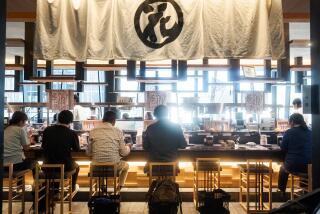Shrinkage in Japan’s Silk Exchange
- Share via
TOKYO — A man in a business suit claps two wooden blocks and the auctioneer on the shallow stage begins chanting prices. Facing him, 30 men in white shirt sleeves stand behind a semicircular table and signal with their hands when they want to buy or sell a futures contract.
This is the Yokohama Raw Silk Exchange, one of only two in the world--for now. The exchange is slowly dying. The time between claps of the wooden blocks that open and close the day’s four trading sessions has shrunk to as little as five minutes from half an hour 20 years ago.
Silk farmers have turned to other crops, and factories have closed or moved overseas. That’s because the Japanese are wearing fewer kimono--where most of Japan’s silk ends up--or buying cheaper imported silk as Japan opens its markets.
“It’s sad,” said Jun Koyama, a 20-year employee of the exchange who is manager of general affairs. “We’re losing a traditional industry.”
Silk thread and clothing were Japan’s biggest exports well into the 20th century. The government churned the profits into modern, more profitable businesses such as steel and shipbuilding as Japan ended almost three centuries of isolation.
Even though Japan is better known for cars and videocassette recorders these days, it’s still the fourth-largest producer in the $2-billion global market for silk. China, India and Brazil are larger.
The decline of Japan’s silk industry has accelerated this decade. After years of protecting its market, Japan began importing more silk in 1996. And the nation’s economic troubles the last six years have pinched the market because fewer women are willing to splurge for kimono, traditional wide-sleeved robes that can cost as much as $8,000.
Most Japanese--who began adopting Western clothes about the same time they started exporting silk--only wear kimono on ceremonial occasions.
A third less kimonos were sold in Japan last year compared with 1993, although it’s still a $7-billion retail industry.
“The only people who wear it frequently wear it for their jobs, like geisha and dancers,” said Eiji Miyamoto, a spokesman for Kobe Kiito, which began making raw silk in 1924. “It’s hard to drive a car wearing a kimono.”
Kobe Kiito had four silk-thread factories at its peak in the 1970s. It has closed them all, the last in 1996. Now it simply imports and sells cheaper foreign silk.
Other silk makers are diversifying into other fields. Gunze Ltd., which began making silk in 1896, has stopped and is now Japan’s largest maker of knit underwear.
Katakura Industries Co., which started in 1873, now makes clothing and electronics parts.
Kanebo Ltd. operates two of Japan’s 14 remaining silk-thread factories. It had 16 plants before World War II. Kanebo now makes most of its silk in Brazil.
“I doubt we’ll see demand for kimono coming back,” said spokesman Kyoji Shimada. “It’s a bit sad because it’s nice to see women wearing them.”
The Yokohama silk exchange was founded in 1895. Unlike many exchanges, Yokohama is sedate, with no shoving, yelling traders doing battle in the pit.
Like the others, which trade more prosaic items such as hog bellies or orange juice, the exchange’s job is to protect farmers and their customers from price fluctuations by setting a price on silk a few months into the future.
The contracts are then traded by speculators who make the exchange work by ensuring a ready market, betting prices will fall by selling and buying when they think prices will rise. The world’s only other exchange for silk fiber is in China.
Raw silk is produced in Japan’s Maebashi region, 60 miles north of Tokyo, where farmers raise mulberry bushes and the silkworms that feed on them. When the worms mature, they spin silken cocoons that are dried and spun into fiber.
Since 1960, the number of Japanese silk farms has dwindled from more than half a million to 6,300.
In 1996, under pressure from trading partners complaining about its closed markets, Japan agreed to open up the silk market as part of the General Agreement on Tariffs and Trade, or GATT.
One reason it took so long to open the market is that former prime ministers such as Takeo Fukuda came from silk-farming families. Also, under Japanese law, the countryside carries more weight at the ballot box than cities.
In 1997, trading on the silk exchange, which deals only in silk made in Japan, fell by almost half, to 660,000 contracts from 1.08 million.
Japanese silk prices have fallen to a 40-year low, $35 a kilogram. That’s higher than worldwide silk prices of $30 a kilogram.
Part of the problem is the Yokohama exchange itself, which critics contend kept the price of Japanese silk high.
The exchange is “an artificial environment” to support prices and keep farmers and silk factories in business, said Emil Kattermann, vice president of Seritex Inc., a New Jersey dealer of silk and rayon.
The factories “should have been out of business a long time ago,” he said.
They might have been but for the quasi-government Japan Raw Silk and Sugar Price Stabilization Agency. For 40 years, it kept prices high by buying silk when prices on the exchange fell below the level set by the government. In April, Japan will scrap the agency.
Meanwhile, the exchange is running in the red and is considering merging in October with an exchange in Maebashi that deals in dried silk cocoons.
More likely, trading may move over to the regular commodities exchange in Tokyo, following a pattern set last year when the Kansai Commodity Exchange absorbed the Kobe Raw Silk Exchange.
More to Read
Inside the business of entertainment
The Wide Shot brings you news, analysis and insights on everything from streaming wars to production — and what it all means for the future.
You may occasionally receive promotional content from the Los Angeles Times.










